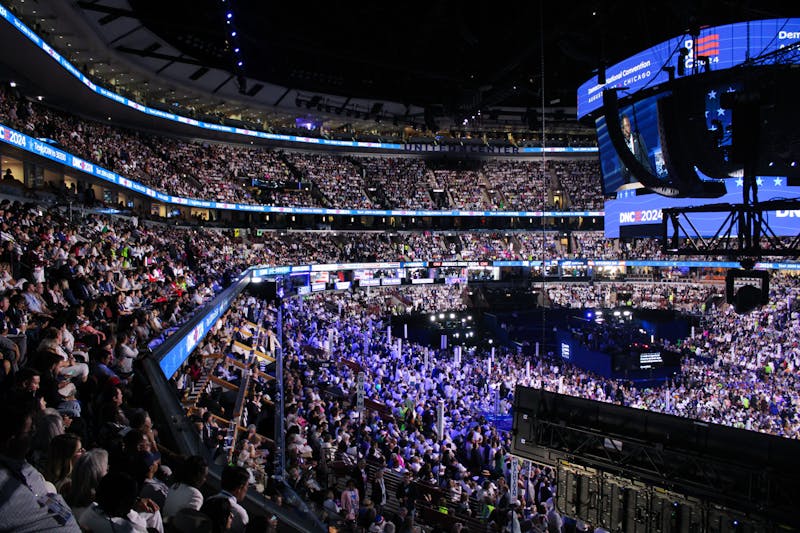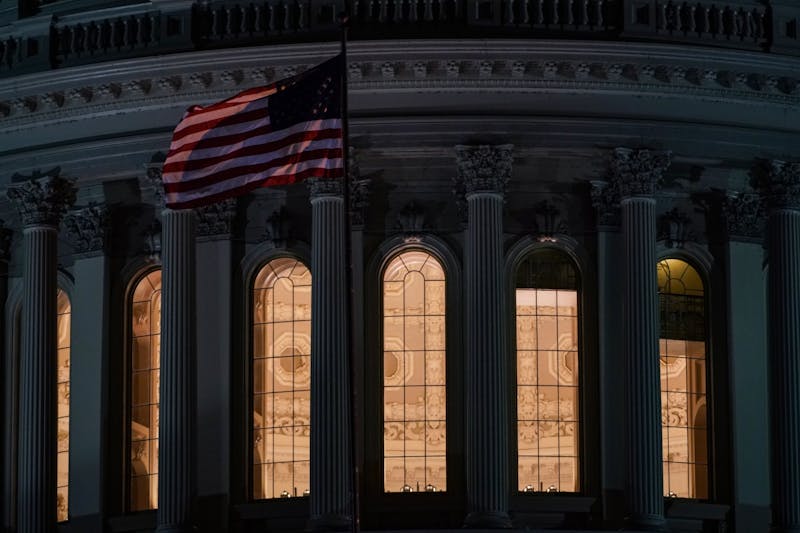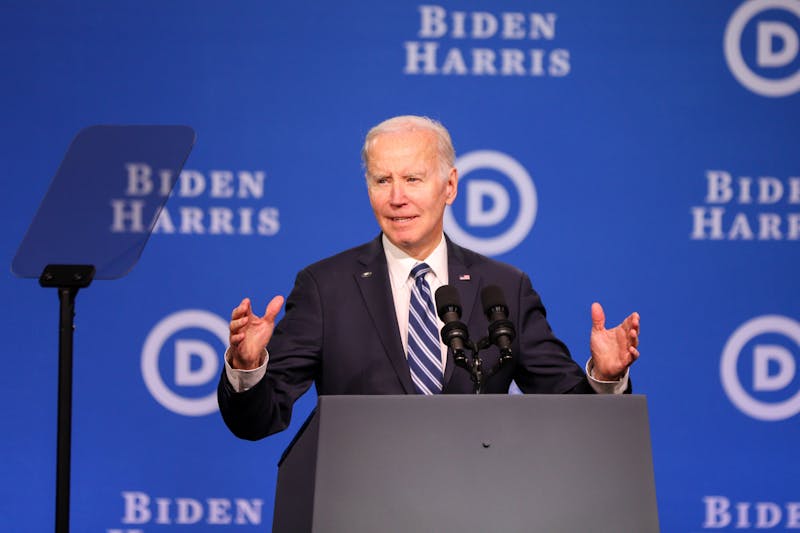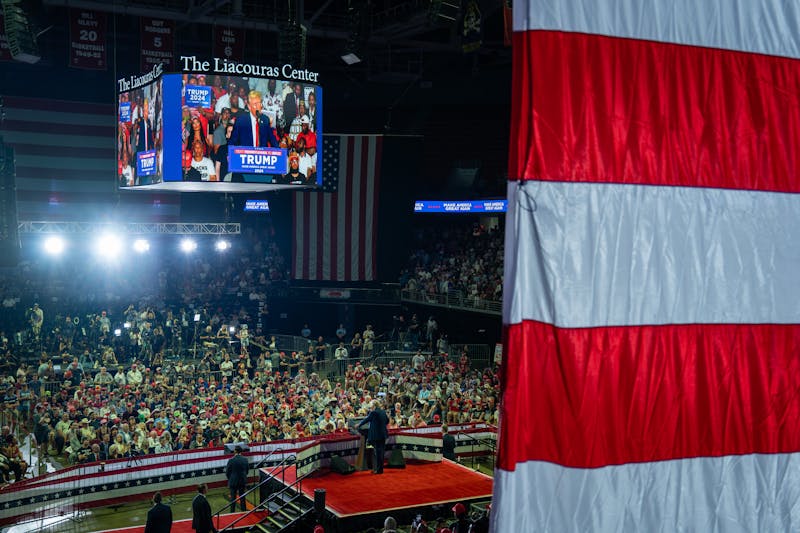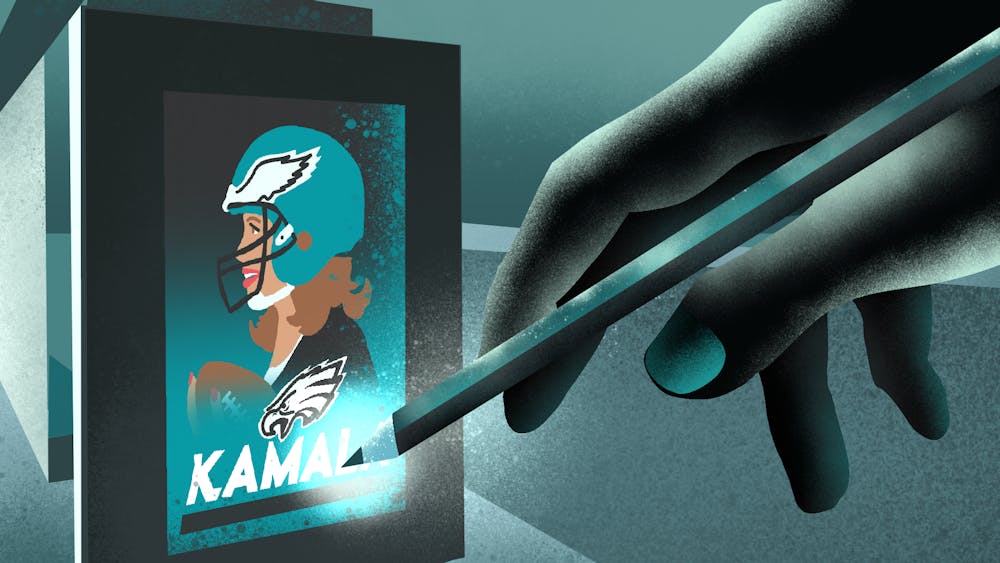
Earlier this month, counterfeit advertisements revealing Vice President Kamala Harris as “the official candidate of the Philadelphia Eagles” were spotted on Penn’s campus and across Philadelphia.
Despite the bogus ads containing the official web address to the Eagles’ voting outreach program, the team denied any involvement with a post on X, the platform previously known as Twitter.
In reality, the mind behind the viral advertisements, which sparked social media debates and conspiracy theories, was street artist Winston Tseng. In an exclusive interview with The Daily Pennsylvanian, Tseng agreed to talk about these advertisements and his career.
Conor Smith: Could you introduce yourself to our readers who may be meeting you for the first time?
Winston Tseng: Sure. I’m a street artist that uses brands and advertising to communicate societal issues, hopefully bringing some unexpected attention to them. My work aims to surprise, amuse, and ideally challenge the public to reflect a bit on the subject matter. Recently I did a parody ad campaign of the Philadelphia Eagles endorsing Kamala Harris for president.
CS: Many people, including some I talked to on Penn’s campus, fell for the Eagles Kamala endorsement ad as a genuine partnership between the franchise and the Harris campaign. Was this your goal?
WT: Not exactly. It was meant to grab attention and cause a double take, but I assumed people would immediately figure out it wasn’t real. I thought the public would see the absurd image of a presidential candidate wearing a football helmet and understand that it was satire.
The whole point of my Eagles-Kamala ad was to satirize political endorsements. Why do we care about them? Why are they such a factor in our elections?
If I really wanted to deceive people, I’d make more realistic looking ads.
CS: What draws you to using existing intellectual property and branding for your art?
WT: A few different reasons. There’s a built-in level of trust and comfort viewers have when they’re out in public and see an ad that looks official. I like to take advantage of that familiarity as a way in to grab their attention, kind of like a Trojan horse.
But more so, branding is such a part of our cultural language today, so it’s a really effective tool to communicate with. When someone sees an ad from a brand they know, they’re already programmed to have certain thoughts and expectations for what they’re looking at. Being able to put the audience in that mindset instantly is a good starting point for my work and allows me to play from there.
Another part of it is just the fun of speaking on behalf of these brands and corporations. The idea of a brand speaking out about a serious issue is just inherently funny to me. It’s a consistent aspect of my work that I think gets overlooked, or people just don’t find it as amusing as I do.
CS: Were you expecting such an onslaught of attention from NFL fans following your installation of the Eagles-Kamala ads? How has this attention compared to previous installations you have done?
WT: Yeah, I had a feeling it would get a lot of attention. Just the mixing of sports and politics, people’s emotional attachment to the Eagles and to the candidates, and the timing of the season starting and the upcoming election. It was like a tinderbox of excitement and attention just waiting to explode.
What I wasn’t expecting was how much media coverage would come out of it. I’m surprised by the amount of articles written and news reports done. I’ve had previous work go viral, but usually it’s just on social media, never to this level of national media attention.
CS: Artist and activist Ai Weiwei penned the quote, “Everything is Art. Everything is Politics.” With many NFL fans pleading to “keep politics out of sports” following your installations, what is your reaction to this mantra?
WT: I understand why some people feel that way, but I just see that as turning a blind eye. Those same fans probably love it when their preferred candidate is being promoted ringside at a UFC fight. Personally, it makes me want to do more and have more fun with it.
CS: Have you had experience with companies taking legal action against you due to your use of their branding?
WT: I’ve received cease and desists before, but nothing beyond that so far.
CS: Are you expecting litigation from the NFL or the Philadelphia Eagles due to your most recent artwork?
WT: I don’t really have any expectations. I’ve been advised that my work is generally protected under fair use, and hopefully they agree.
CS: Philadelphia is going to be pivotal in the 2024 election. You have seen first-hand the varying social media reactions to your recent artwork by Philly natives. What do you think politicians and social activists miss in their appeals to Philadelphians? What do they get right?
WT: I don’t think I’m the right person to be advising or critiquing their work; they have a very different set of rules to play by and goals they’re working towards. They need to be direct and clear and leave no room for misinterpretation or confusion.
I’ll just say for my work, though, humor and familiarity can go a long way. And communicating emotionally and culturally, not just rationally, can be really effective.
CS: I would be remiss to ask this, but are you a Philadelphia Eagles fan, yourself?
WT: I’m not originally from Philadelphia, so I don’t claim to be a true die-hard Eagles fan. But I support them. Monday’s loss was brutal. Some people on social media were blaming my posters, which is hilarious.
CS: You have spoken about the rampant backlash you have faced from conservative critics due to your work. What was the craziest response you saw on social media to your latest installation?
WT: I haven’t seen anything too crazy directed at me. I was called a pedophile and a bunch of anti-Asian, racist things, but that’s pretty much par for the course at this point.
For the most part, I think the attention has been on conspiracy theories. That’s been the craziest response. Laura Loomer was really pushing a lot of insane stuff over and over again on all her platforms, which is dangerous but also ironic considering the storm of attention and backlash she’s under right now.
CS: In a 2021 interview with Juxtapoz Magazine, you stressed that you are “not necessarily trying to change anyone’s mind” with your artwork. In our current political moment, do you still hold this sentiment?
WT: I do, in the sense that changing someone’s mind directly from A to B isn’t a primary goal of my work, and I don’t think it’s very likely in the current political moment. Of course it would be nice, but I think that would put my work more aligned with propaganda or activism, which isn’t the true purpose. My aim is to highlight issues and provoke reflection today, and hopefully create work that people can look back on to understand our times better.
CS: Finally, should we expect to see more from you before November’s election?
WT: Yeah, but less in the street and more in the gallery setting. I’ll have new work in an exhibition next month at Subliminal Projects, AMERICAN PUNCHLINE, curated by Sara Lois Kaplan. It’s a timely show featuring a range of contemporary artists focused on political and social issues, so please check it out.
The Daily Pennsylvanian is an independent, student-run newspaper. Please consider making a donation to support the coverage that shapes the University. Your generosity ensures a future of strong journalism at Penn.
Donate




